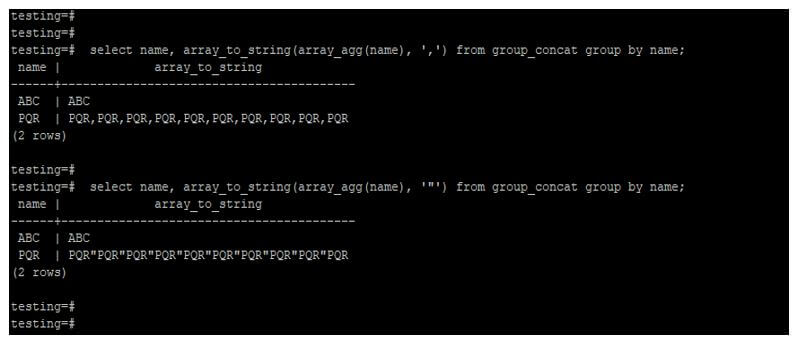

SELECT unnest(string_to_array(sentence, ' ')) AS parts You want to split the sentences by the space character. In the sentences table, there are some sentences. This will produce a column with all string parts, each in a separate row. SELECT string_to_array('It''s an example sentence.', ' ') AS parts A simple use of the string_to_array(text, delimiter) function: The text is the text you'd like to split, and the delimiter is the string (here, a space) by which you'd like to split the text. To get all parts of the sentence as elements of an array in PostgreSQL, use the string_to_array(text, delimiter) function. String_to_array('It''s an example sentence.', ' ') You have a sentence, and you'd like to split it by the space character. Queries.You want to split a string in PostgreSQL.
Postgresql array functions code#
So that they may replace thousands of lines of code with very simple PostgresQL, which teaches SQL to developers This article is an extract from my book The Art of If you see yourselfĭoing that a lot, it might be a good sign that you really needed a lookup Instead, and filter elements with a where clause. Over arrays elements really is inefficient, so learn to use unnest() Situations where you do a lot of lookups, though.Īlso, some PostgreSQL array functions show a quadratic behavior: looping Not so efficient that you would replace a lookup table with an array in Indexing support makes them efficient to work with. Gold Spike Hotel & Casino │ Los_Angeles │ 10įruitville Elementary School │ New_York │ 8 Jw Marriott Miami Downtown │ New_York │ 11 Sleep Inn & Suites Intercontinental Airport East │ Chicago │ 19 Order the data set by most promising opportunities: name │ tz │ count The where clause only matches the hashtagĪrrays containing both the #Hiring and the #Retail tags. Lateral allows picking the nearest location to the tweet location from our location limit 1 ) as geoname on true where hashtags array group by name, tz order by count desc limit 10 įor this query a dataset of geonames has been imported. Select name, substring(timezone, '/(.*)') as tz, count(*) from hashtag left join lateral ( select * from geonames order by location hashtag. Tags themselves, rather than each array as an opaque value. This indexĪccess method allows PostgreSQL to index the contents of the arrays, the Indexing PostgreSQL Arrays for Statistics and Profitīefore processing the tags, we create a specialized GIN index. In the following data output, you can see that we kept the # signs inįront of the hashtags, making it easier to recognize what this data is: id │ hashtags Select id, hashtags from hashtag limit 10 This capabilityĪs we are interested in the tags used in the messages, the next query alsoĮxtracts all the tags from the Twitter messages as an array of text. As introduced above, what’s interesting with PostgreSQL is itsĪbility to process array elements from SQL directly. PostgreSQL has built-in support for arrays, which are documented in theĬhapters. WeĬan create a simpler relation to manage and process a subset of the data Single point entry, allowing much more interesting processing again.
Postgresql array functions how to#
PostgreSQL does know how to handle longitude and latitude as a The date and hour fields are separated for no good reason,Īnd it makes processing them less easy than when they form a timestamptz We can see that the raw import schema is not a good fit for PostgreSQLĬapabilities. │…yer, Mets, Jets, Rangers, LI Ducks, Sons of Anarchy, Surv… \pset format wrapped \pset columns 70 table tweet limit 1


 0 kommentar(er)
0 kommentar(er)
